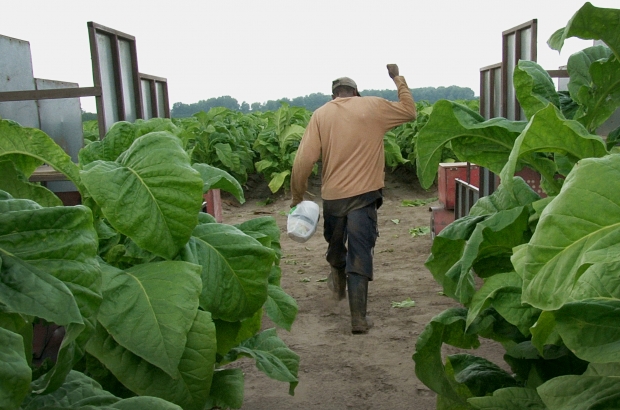- Daily & Weekly newsletters
- Buy & download The Bulletin
- Comment on our articles
Brussels artist Pieter Geenen on borders, migration and identity
Brussels-based audiovisual artist Pieter Geenen has a fascination for slow corroding images, sounds and words. In This Land is My Land. This Land is Your Land., his new solo show at Argos in Brussels, he takes his detached approach to the Canadian tobacco belt. In the footsteps of Flemish migrants, he researched what it means to have an identity.
In the video The Land (2015), the camera follows Marc Vanden Bussche, as he guides the viewer around the Irrigation Learning Centre he manages. “We’re in the Delhi/Tillsonburg region in south east Ontario,” Geenen explains. “A lot of Flemish migrants came here between the wars and just after the Second World War, when local tobacco growing was enjoying its heyday.”
Vanden Bussche’s father was a pioneer in cultivating the land, starting his own irrigation company. What’s important from Geenen’s perspective is that he also established a lot of infrastructure for European migrants who were new to the area. With jerky camera movements the artist puts himself in the role of an explorer, just like the original colonisers of the land.
“My angle is always contemplative,” he says. “Here, I’m taking the viewer from an environment of unspoilt nature to where culture and exploitation enter the landscape, raising questions about colonial structures. There are references to the past, but it’s striking that today it’s still white farmers offering seasonal employment, now delivered by workers from the Caribbean.”
The power of suggestion
For Geenen, who travelled to the area five times during this three-year project, there’s a personal connection. “When he was still a student, in the summer of 1967, my father worked in Tillsonburg to help the Belgian tobacco farmers with the harvest. His stories and memories were a trigger for me.”
So are the letters shown here – correspondence between migrant workers and the ones left behind in the home country – also personal? “Like with everything in this exhibition, I like to visit the border between fiction and reality,” Geenen says. “So it stays unclear. The correspondence is based on conversations I had with all kinds of people. For me it was an ideal way to create a certain geographical distance.”
Geenen, who has a Master’s in photography and completed the postgraduate transmedia programme at Sint-Lukas school of art and design in Brussels, started adding text elements to his art in 2011. “It brings an extra layer of information to my work that isn’t resonated by images or sound, and it offers a certain rhythm. All the works here relate to each other. One can help to understand the other.”
The challenge was not to put all the things he wanted to say in one documentary, but to combine all these layers and tell this complex reality in his very own quietened-down and, at first sight, maybe not very significant way. As with most of Geenen’s art, a lot is suggested and unspoken. Photos are often hazy, and visuals move slowly.
“This approach corresponds with my personality,” he explains. “I believe in the emotional impact of a subtle, more intimate approach. To me it’s more intense than a fast string of sensational and dramatic images. If you slow down things and freeze time, you’re forcing the visitor to take a second look and think again. Very explicit, ‘what you see is what you get’ images don’t offer such a reflexive environment.”
A phone book opened to a page with the name Vanden Bussche emphasises the number of locals with Flemish roots and is perhaps the most in-your-face artefact you see here. “A telephone directory offers an index of migration waves. Other pages will emphasise the Latvian, Polish or German presence in the region.”
Abstract borders
Geenen was struck by the fact that almost all the Belgians he met are proud of their roots, even if they don’t live a very Belgian life. “They did maintain an archetypical, sometimes even artificial Belgian spirit, dominated by cliches, based on childhood memories and often cultivated by the Belgian club they are in. As a result, national identity becomes a utopian ideal from the past.”
Sometimes Belgian and North American culture interweave. Two images have a Belgian flag planted in the front garden. “Here the typical Belgian prudence is replaced by American pride. The attitude has changed, but not the roots.”
For Geenen, it’s only human that migrants coming this way seek each other’s company and want to maintain their home culture. “Today all these national clubs in Canada may look rather anachronistic, but back in the day they were the only place where migrants could speak their mother tongue and practise their hobbies. Belgians tended to marry other Belgians, and often they met at the club.”
It’s not the first time Geenen has displayed work about borders, migration and identity. He visited Lampedusa long before it was a headline in news stories about migrants, and soon he will be showing and commenting on an excerpt from Mirador, a video he shot at a panoramic site in Gibraltar, where the banality of the tourist conversations clashes with the raw reality on the other side of the water.
“I always seem to connect the geographical to the social,” he says. “If I look at a map and see all these abstract lines, so-called borders, I want to check how they translate into reality. In real life, I always notice it’s not as black or white as indicated. There’s always a grey transition zone.” This blurred zone is the key to his works.
This Land is My Land. This Land is Your Land, until 20 December, Argos, Brussels Centre for Arts & Media
Mirador (work in progress), 5 November, Beursschouwburg, Brussels
Photo: Pieter Geenen, This Land is My Land. This Land is Your Land., 2015. Courtesy of the artist



















